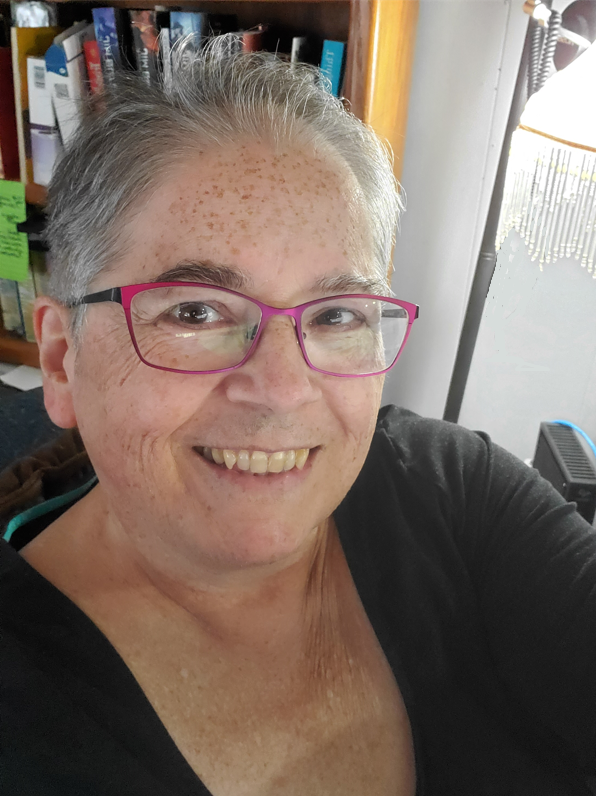

Heather Martin Naomi Martens
As everyone in BC will recall, much of the province was hit with extreme rainstorms last fall. The result was major flooding and road damage in the Fraser Valley and beyond, cutting whole communities off from the rest of the province. Amid the tragedy and desperation experienced by many, Fraser Health peritoneal dialysis (PD) nurse, Naomi Martens, and PD patient, Heather Martin, took on the challenge of training Heather 100 percent via Zoom to manage her own life-sustaining, home-based dialysis.
First time training a success for patient and nurseNaomi says Heather was a pro who made her job really easy: “I think she is really adventurous for trying so many new things at once – all that goes into learning PD and knowing that it was my first time as a nurse training a patient by Zoom. I am impressed at how she was willing to try to make the best of a bad situation, being isolated due to flood damaged roads.”
Normally, Heather would have visited Abbotsford Regional Hospital in person for the training with Naomi who works in the PD unit, but the flooding made that impossible. Fortunately, all of Heather’s PD supplies had been delivered to her home just before the flooding, so getting them to her wasn’t an issue.
Extensive trainingThe training included how to do safe connections between the patient, the solution bag and the drain bag, as well as how to assess fluid balance and treatment, and identify and solve problems. Learning all of this isn’t a quick and easy process. Normally, a total of 12 hours of training would take place in person and would include a mix of information sharing, discussions, demonstrations and practice. Heather and Naomi moved all of that online and had three Zoom sessions of approximately four hours each.
Naomi explains that it was almost like being in the same room together except that they could only view what the camera was pointing at: “For the parts of training that are hands on, I would show Heather a demonstration and then she would demonstrate back, making sure the computer camera could capture what we both needed to see.”
Benefits of online trainingHeather says there were many advantages to doing the training online: “The biggest benefit was starting dialysis without waiting – it was a huge relief in the midst of flooding and being cut off from renal support. It was definitely also directly beneficial to my health – I very much needed dialysis!”
She continues, “There is also an organizational advantage to doing training at home. For example, it’s easy to contaminate your transfer set if you reach across your body to dispose of the cap. At home, I re-positioned my wastebasket to my left to eliminate this problem. I don’t know if I would have remembered that detail at home if I’d learned it with a lot of other information at the PD unit. I know this sounds minor, but peritonitis (involving inflammation due to infection) is one of the most serious issues someone on peritoneal dialysis can face, so reinforcing good habits in the home setting has real value.”
Naomi adds, “Heather did not have to travel the 45 minutes it would have taken to get here, and 45 minutes home.” She also points out that the training took place during pandemic restrictions, which continued into 2022, and that training via Zoom allowed for interaction while maintaining physical isolation, which is preferable for dialysis patients who are in the category of ‘clinically extremely vulnerable’ to COVID-19.
Virtual training isn’t for everyoneWhile Zoom training may increasingly be an option for some PD patients, it’s not suitable for all. This is due to possible technology challenges as well as the general comfort level around virtual training of both the nurse and patient involved.
Naomi explains more about why it worked so well with Heather and why it might not work as well for others: “If someone is already learning something new, and especially something life-sustaining, there is already a level of anxiety present. As an educator, you do not want to overwhelm the learner with too many new things. Heather was a gem in this respect as she is fairly tech savvy and is comfortable with virtual platforms. Also, I think that Heather has a good sense of self-confidence, which made her up for the challenge.”
Patient advice for future trainingWhile Heather says there isn’t anything she would have changed for her training, she has some ideas for what could help others: “For nurses: get a template from Naomi! She did a fabulous job. For patients: I suggest providing a training session in how to use Zoom for people who are interested but hesitant about Zoom or remote learning. Perhaps offering a test session at the clinic would allow patients to feel comfortable enough to have some training sessions from home. It’s such a time-saver for people like me, who are still working. And I also think it helps with exhaustion as a trainee doesn’t have to travel. Don’t forget that people are often at a very low energy level just before getting on dialysis.”
A few drawbacksNaomi says some of the training techniques and tools she would normally use were not applicable for virtual training. “For example, usually the first sterile connection a patient practices is with a practice catheter, not their own. Heather had to do that first connection with her own catheter without the benefit of me to assist with my own hands if something went awry.”
She continues, “We also usually draw blood for bloodwork while the patient is at the hospital and were unable to do that. Instead, Heather went to an outpatient lab afterwards, which she could access despite the flood damage.”
She adds, “Any physical assessment I would be doing during training was limited to what I could see and how well Heather answered my questions or what she thought was important to report.”
Also, the lack of opportunity for in-person interaction to help build rapport and a therapeutic relationship could be a drawback for some. However, Naomi says, “Heather is such a friendly and open person that she made it very easy to get to know her.”
Patient enthusiasmWhen asked if she would consider being trained again via Zoom, Heather says, “Heck, yeah! In addition to the health benefits, it was also seriously fun. Naomi is witty and kept the training interesting.”
Peritoneal dialysis basics Home-based dialysis supports improved quality of life and health outcomes when compared to conventional dialysis, and BC is proud to have the highest PD rates in the country. Patients and/or family members receive training to manage all aspects of PD care and have access to a multidisciplinary team including a nephrologist, PD nurse, pharmacist, social worker, and dietitian.
For those wishing to learn more about peritoneal dialysis, BC Renal has a web page for patients that includes more information and several resources, including booklets, videos and training modules:
Peritoneal Dialysis

